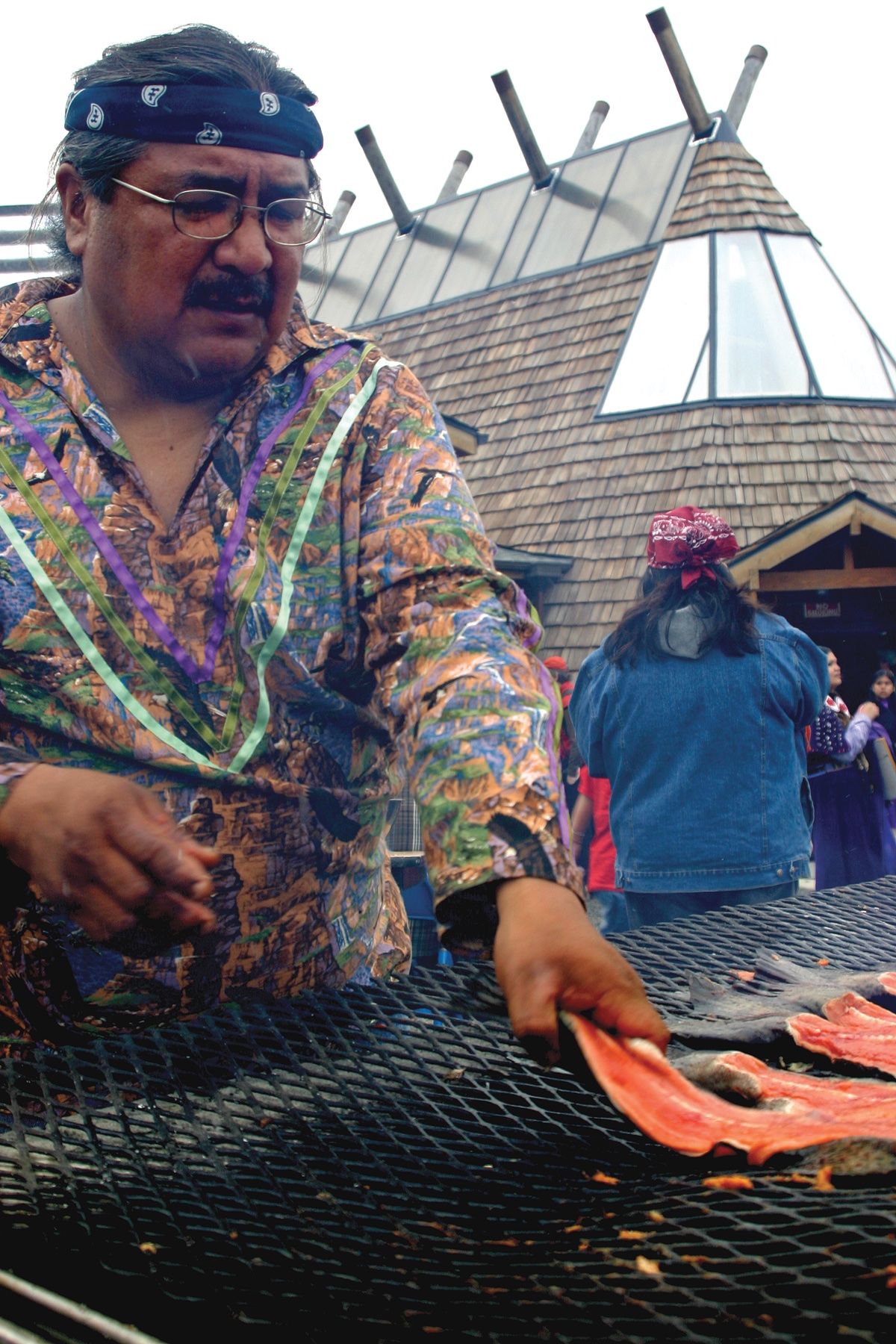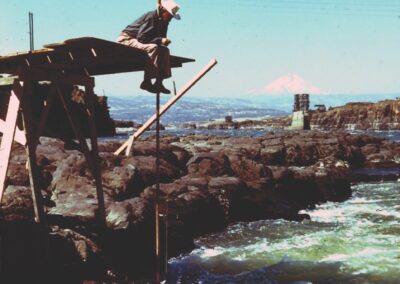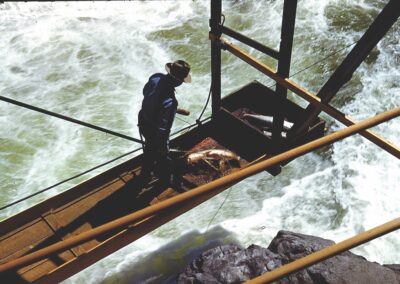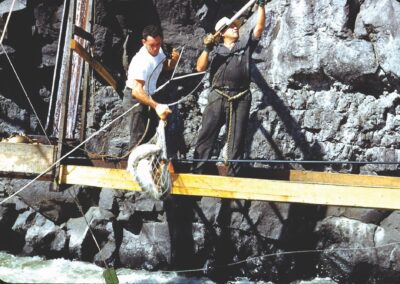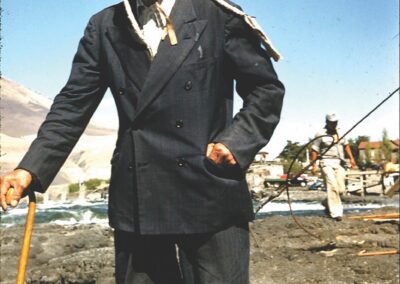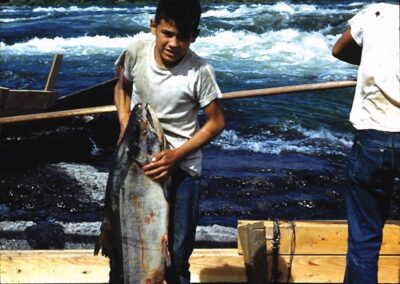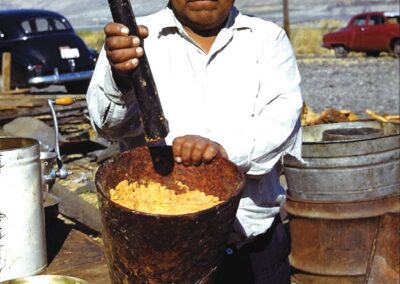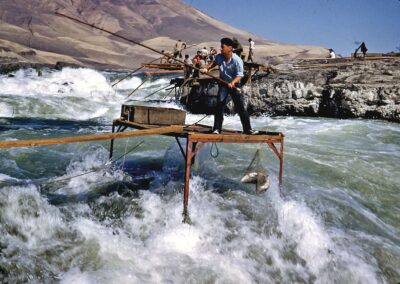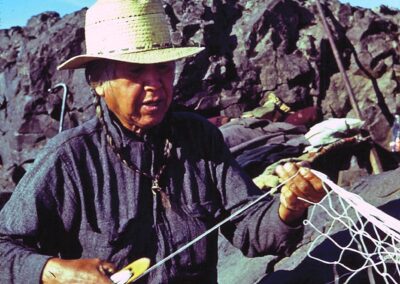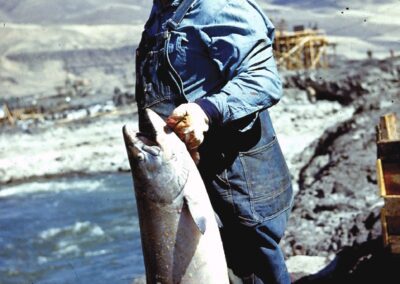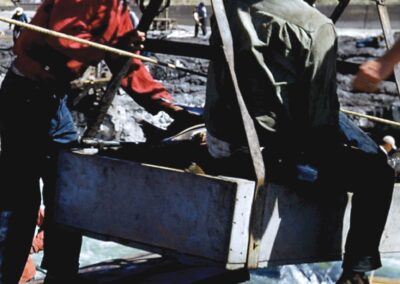Celilo Falls
The center of trade and heart of the region’s salmon culture for thousands of years.
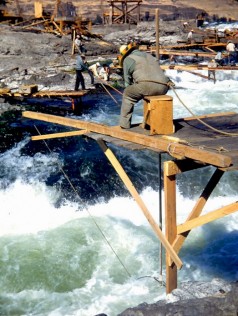
Fishing for salmon at Celilo Falls was a dangerous endeavor. Many fishers wore rope safety lines, because an untethered fall into the roiling waters was usually fatal. Photo: Matheny collection
For centuries Indians caught the giant chinook and other food salmon that struggled to make their way upstream through the rocky barrier of tumbling waters and swift, narrow channels of the Columbia River known as Celilo Falls, or Wy-am. During the spring flooding, ten times more water passed over this spectacular waterfall than passes over Niagara Falls today. The ancient ones left a record of their lives in the ashes of campfires and buried sanctuaries of their dead. They left tools and weapons, items of adornment, and samples of their art. Their record of habitation proves Wy-am to be one of the longest occupied sites on the continent.
For thousands of years, Wy-am was one of history’s great market places. A half-dozen tribes had permanent villages between the falls and where the city of The Dalles now stands. As many as 5,000 people would gather to trade, feast, and participate in games and religious ceremonies.
Elders and chiefs regulated the fishing, permitting none until after the First Salmon ceremony. Each day, fishing started and ended at the sound of a whistle. There was no night fishing. And when a fisher was pulled into the water – most who fell perished in the roiling water – all fishing ceased for the day. In later years, each fisher was required to tie a rope around his waist, with the other end fastened to the shore. Elders and others without family members able to fish could take what they needed from the catches. Visiting tribes were given what they could transport to their homes. The rest belonged to the fishers and their families.
All this changed on the morning of March 10, 1957, when the massive steel and concrete gates of The Dalles Dam closed and choked back the downstream surge of the Columbia River. Four and a half hours later and eight miles upstream, Celilo Falls, the spectacular natural wonder and the age-old Indian salmon fishery associated with it was under water.
That was more than 50 years ago. But the spirit of Wy-am – which some say means “echo of falling water” – still lives in the traditions and religions, indeed in the very soul of Columbia River Indian people.
When the United States government submerged Celilo Falls in 1957, it compensated the tribes for flooding their fishing sites. It did not, however, purchase their fishing rights. Those rights, as set forth in the 1855 treaties, were not in principle affected when the government paid for inundating tribal fishing sites, but the tribes’ economic base was shattered. Francis Seufert in Wheels of Progress, his book about his family’s many years as cannery owners and operators in the Celilo area, explained, “The government, in paying the Indians for destroying their fishing sites at Celilo, was doing no more for the Indians than the United States government did for Seufert’s when they bought Seufert’s shore lands that were flooded out by The Dalles Dam pool.”
Words of our Leaders
Celilo still reverberates in the heart of every Native American who ever fished or lived by it. They can still see all the characteristics of the waterfall. If they listen, they can still hear its roar. If they inhale, the fragrances of mist and fish and water come back again.”
—Ted Strong, Yakama
An Indian Trading Center
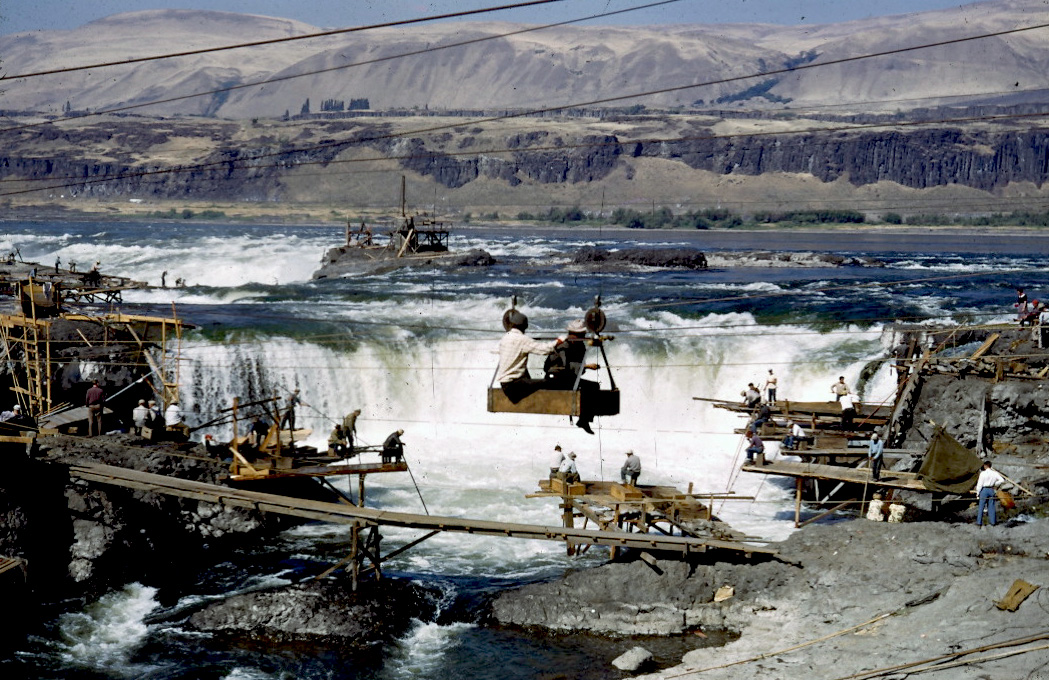
Celilo Village
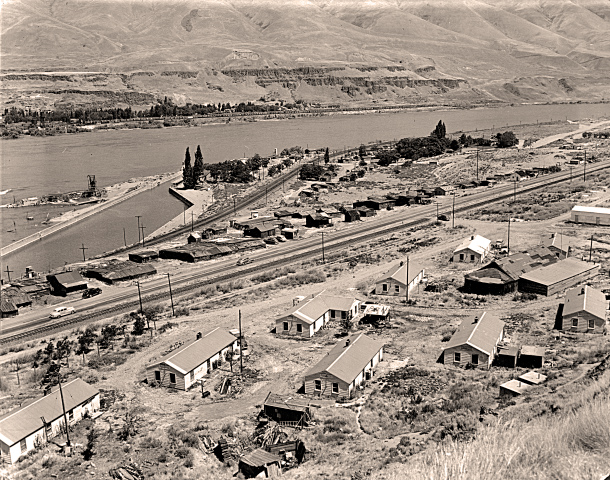
Rite of Passage

Related Links
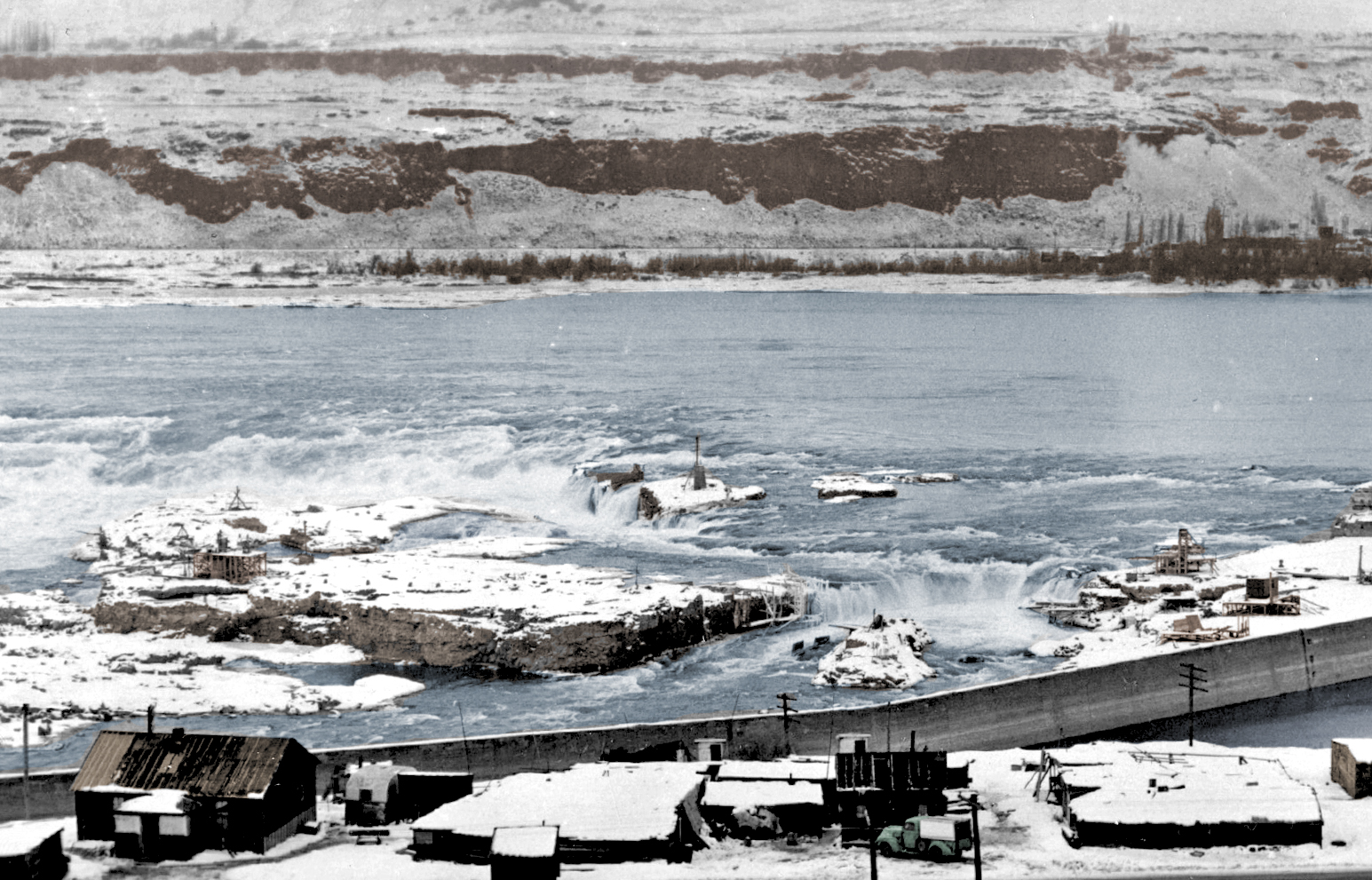
Remembering Celilo Falls
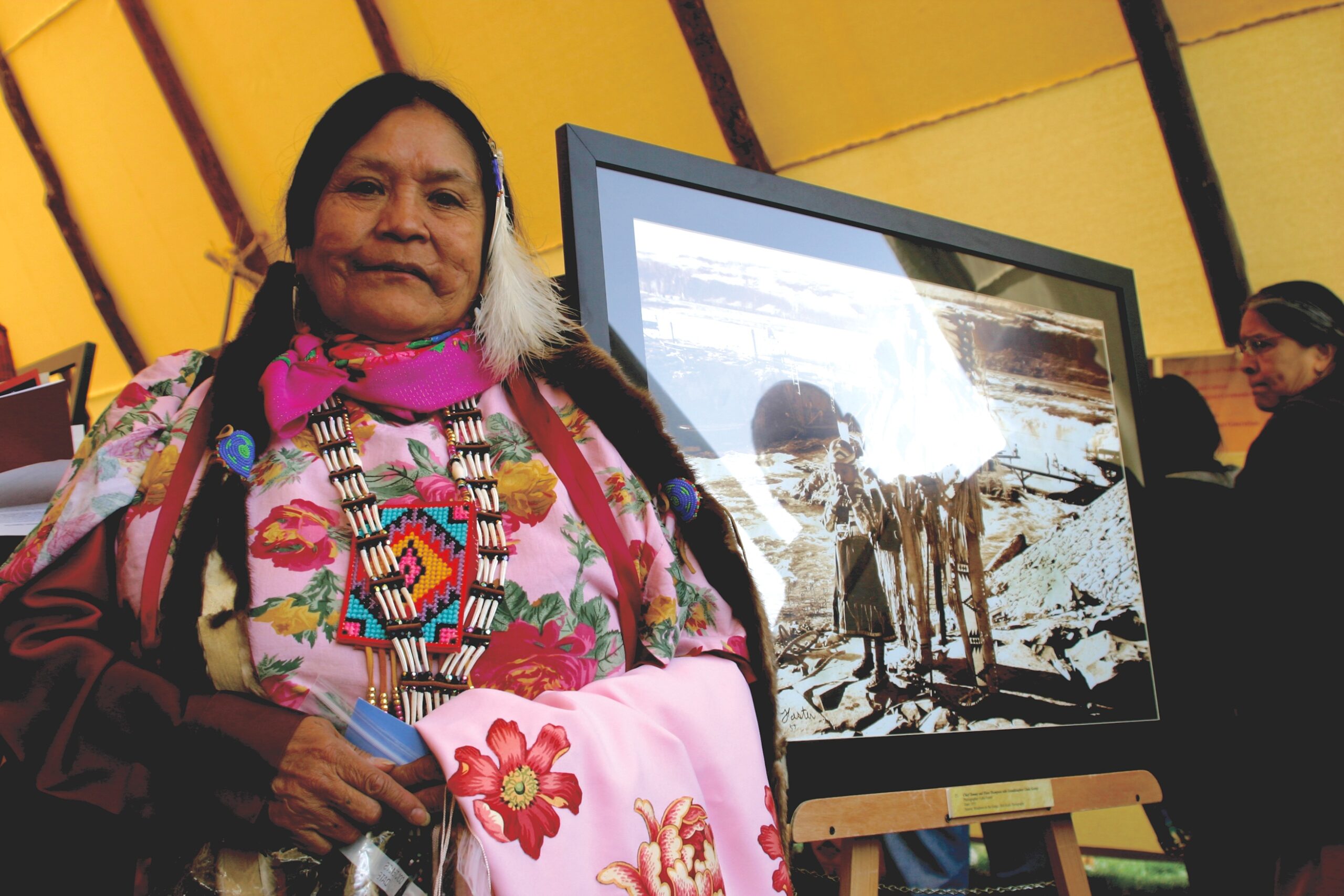
excerpt from a CRITFC article written about the Celilo Legacy event, a commemoration of the 50th anniversary of the flooding of Celilo Falls in 2007
Linda George Meanus, warm springs/yakama, smiles as she stares wistfully at the large, framed, black-and-white photograph showing a little girl standing next to former Celilo Village Chief Tommy Thompson and his wife, Flora.
In the well-known photo, taken in 1956 by Lafie Foster, the three are at the edge of Celilo Falls, wearing traditional tribal regalia, including Chief Thompson in a headdress and holding an eagle feather fan. The falls, called “Wy-Am,” the Sahaptin language word for “echo of falling water” or “sound of water upon the rocks,” are visible in the background as a sheer, white wall behind a maze of fishing scaffolds. It’s a sunny day, and men with long dip nets are scattered atop the platforms competing for migrating salmon gathered in the foaming waters below. Rolling hills tower in the hazy distance above the Columbia River’s northern banks.
The little girl is Linda—5 at the time, she recalls—the granddaughter of Chief Thompson. In the photo, she appears to be trying to cover her face. Her smile evaporating, George, now 56, pauses, then explains.
“I didn’t want to have it taken,” George says of the picture. “I knew something was going to happen. Even as a little girl, I knew something was wrong. You can feel it when you’re young, just like animals can feel it when something’s wrong. I think I was already feeling sad.”
Just months after the photo was taken, on March 10, 1957, the United States Army Corps of Engineers completed work on The Dalles Dam eight miles downstream from the falls, shutting the flood gates and causing millions of gallons of raging river to grind to a halt. The river’s water level slowly rose behind the 1.5-mile-wide dam, eventually reaching the falls, spilling over and filling them in a matter of minutes.
The roar that for time immemorial echoed off the bluffs and canyons soaring from the Columbia River’s restless, treacherous banks, and which some say could be heard for 10 miles, was silenced.
“They didn’t want me to watch it on TV or look at it when they flooded it,” George says of her family.
“I was in Marylhurst Catholic School. That’s why they put me in there, so I wouldn’t watch the flooding. But they had it on TV so I watched it and I cried. I still cry, even when I come here because I remember so plainly watching it when they flooded it. When my grandmother showed it, she cut my hair. When we lose somebody in the family, we cut our hair. It’s to mourn, to grieve.”
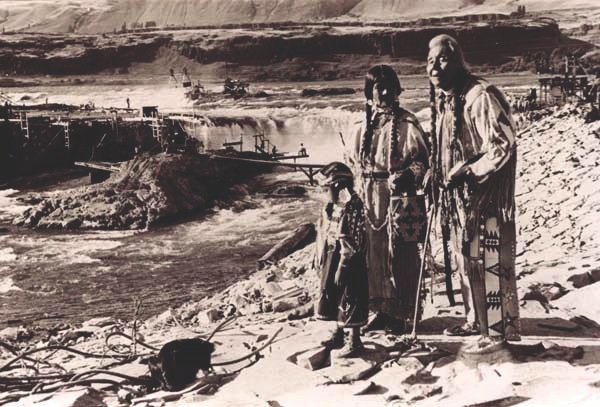
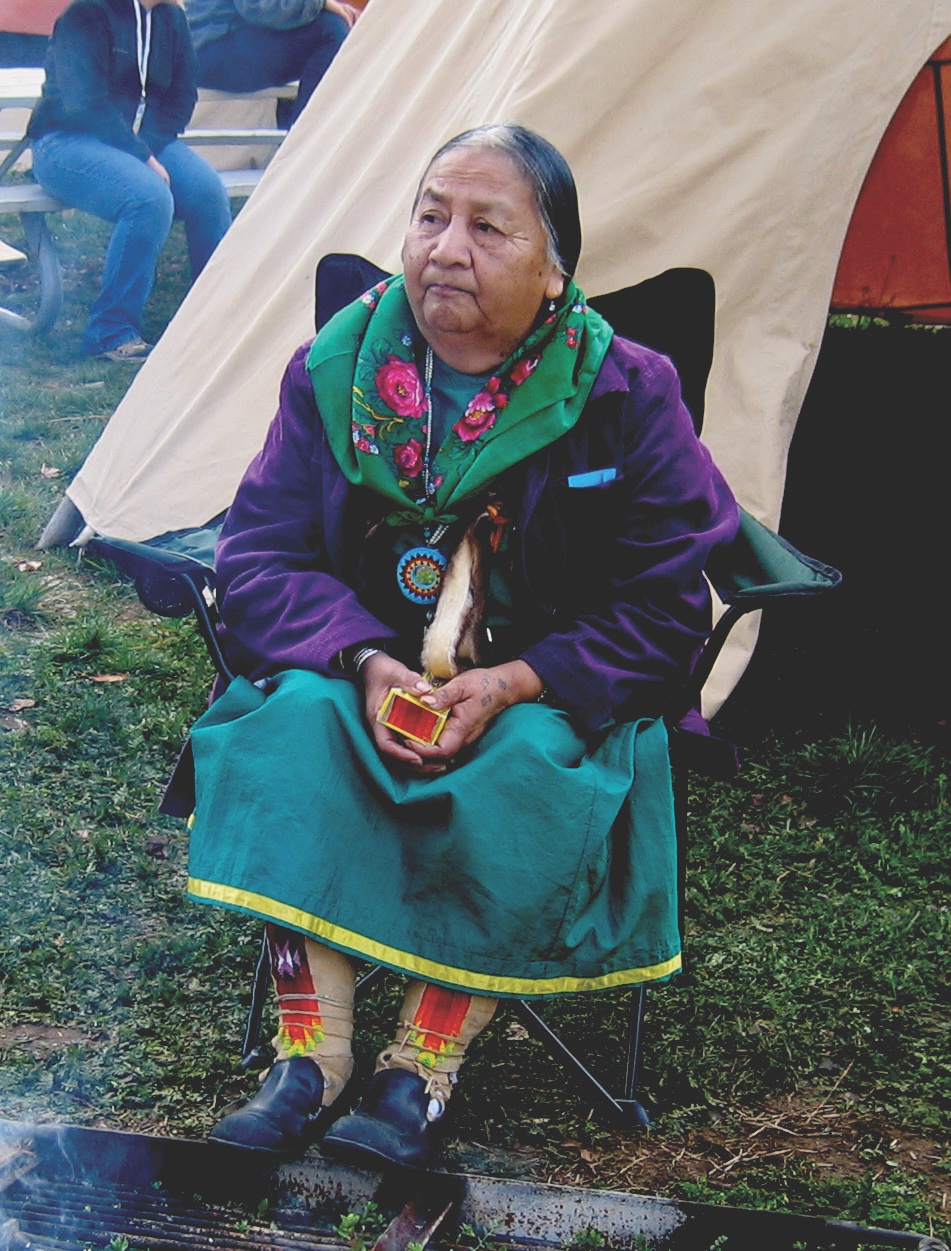
Geraldine Jim, warm springs: “I remember the falls. I remember my mom and dad fishing, and my brothers. They were young. It was a teaching here. A life to live. But it was hard. It was really hard. It was hard for us to see the falls go under. That was our life.”
The power of Celilo Falls helped me learn to respect the river.
Celilo in Pictures
From 1951 to 1952, Raymond Matheny worked for the US Fish and Wildlife Service near The Dalles Oregon gathering data to assess the value of the Indian fishery at Celilo Falls, obtaining names and tribal affiliations of fishers, and taking sample weights of the netted fish. After reading about the Celilo Legacy Commemoration in 2007, Raymond and his wife, Marie, (at right in 1952) donated copies of 273 images he had taken of the Celilo Falls fishery to CRITFC for education purposes. This selection of photos below were taken in 1952, five years before the falls were flooded.
Below is an excerpt from the photographer notes Matheny prepared to go along with the photos:
The original treaty granting fishing rights to the Indians dates back to 1855. Fishing sites are inherited or initially located by the Indians. Any complaint as to rights to fish at any location is settled by the tribal councils and the Celilo Fish Committee composed of representatives of all of the tribes. Several tribes of Indians, namely Yakima, Nez Perce, Warm Springs, and Umatilla fish for salmon at Celilo.
They use nets sewn around an iron ring attached to a wooden or aluminum pole of varying length. Fishing is done from wooden platforms weighted down with rocks and natural dipping places or rocky ledges. There are several methods of using nets attached to poles to catch fish. They are: roping, dipping, and simply using a set net placed in foaming, swirling water. Roping involves lassoing fish actually seen swimming upstream in shallow water, whereas dipping is merely sweeping a smaller net in “white water.”
The Indians fish by themselves or frequently in companies, dividing the money resulting from the fish sold. It is a ruling set up and enforced by the various tribal councils that the Indian who is fishing must wear a safety rope around his waist. Many Indian fishermen have drowned at Celilo by slipping into the swiftly flowing Columbia River.
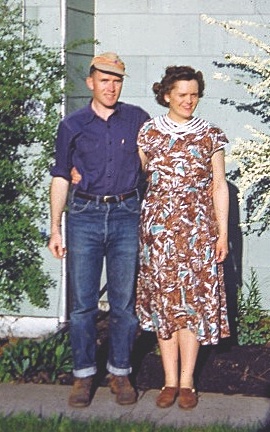
Photographer Raymond Matheny and his wife Maria.
Scaffold fishing at Tenino
Henry Polk at ‘Cement’ Tenino near The Dalles with Mt. Hood in the background, July 1952.
Standing Island fishers
Norman Kittson and Doug Foster with three salmon in their net fishing from a hanging platform on Standing Island, Aug 1952.
Young fishers at Celilo
Francis McFarland gets some help with a salmon caught on Chinook Rock, Sept 3, 1952.
Salmon as Big as the Fisher
An unnamed fisher holding up a 32-pound Chinook caught on Stand Island, Aug 1952.
Preparing c’lai
William Winnier pounding dried salmon into c’lai near the Celilo railroad bridge, Sept 1952.

Celilo Still Connects Tribes to Our Culture
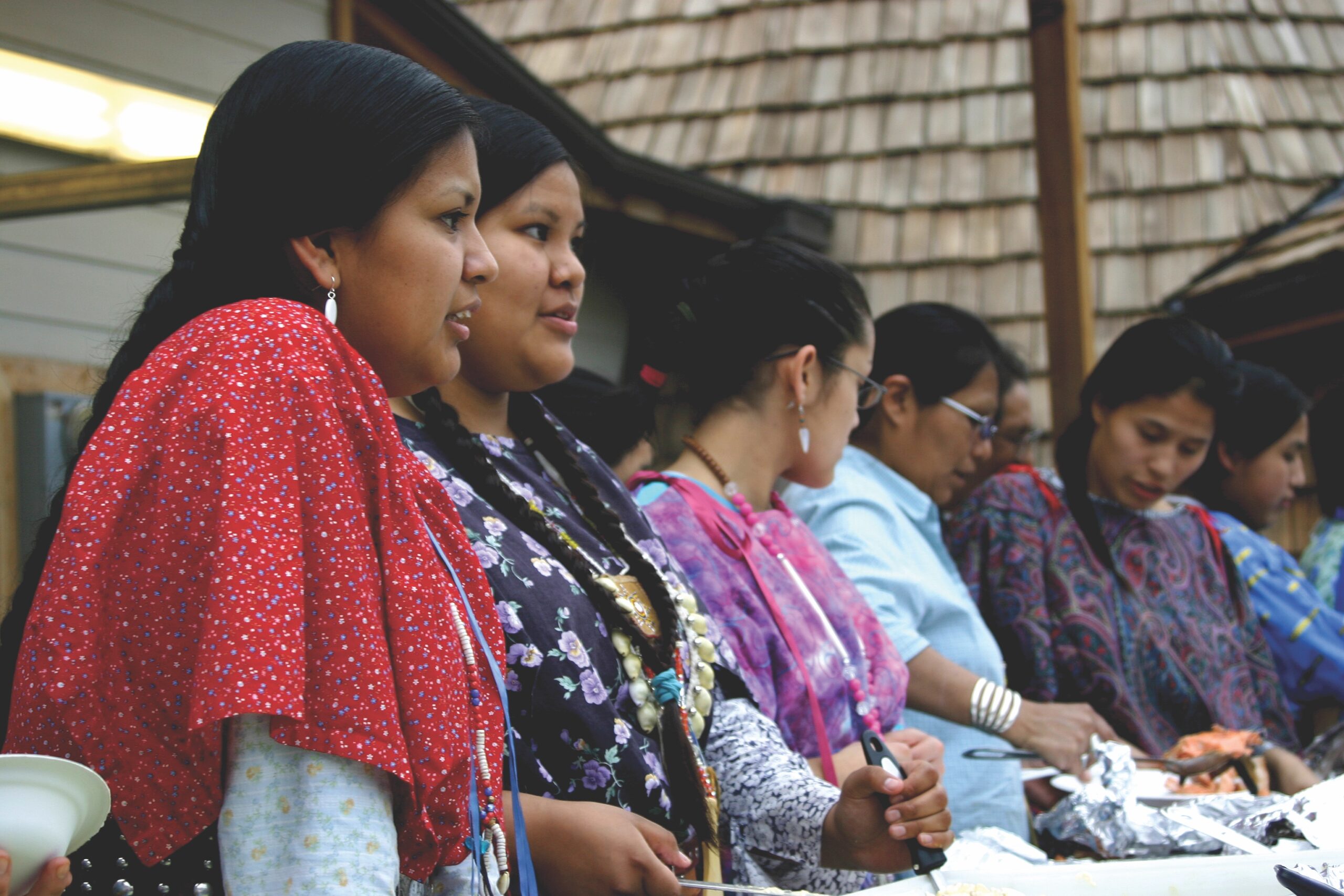
“There’s a huge symbolism here at Celilo and it’s very sad that there are fewer and fewer people who actually experienced Celilo,” says Olney Patt, Jr, warm springs. “As we get down further and further from that time, we’re going to see fewer and fewer people who actually got the salmon out of the waters at Celilo. I think those people who actually did that are becoming a very precious resource to the younger people to keep them in touch with what was once here.
“In many cultures, the further you get away from the source of the culture, the tougher it is to keep it as part of our culture, as part of your beliefs and your lifestyles. Here on the river, though, people’s devotion to the salmon itself will keep that alive. And you see it here, with young people dressed up in their wing dresses and taking part in the ceremonies and being reverent during the ceremonies.”
Words of our Leaders
“I’m always impressed with my people because we’re like the salmon. You can put up dams. You can put up shelters. You can poison the waters. But we’re still going to be here.”
—Terry Courtney, Jr, Warm Springs
